<1>Marketed primarily to the middle class, Punch “had a remarkable penchant for uncovering connections—not only in figurative form . . . but in parallels, analogies, echoes, wherever likenesses or contrasts could be used” (Johnson 274; Altick xxiii). For example, Punch portrayed Prince Albert and Queen Victoria as farmers and garbed Lord John Russell and Robert Peel as Sairey Gamp and Betsy Prig. Creating a parallel for their object of criticism allowed them to embody “their point in a visual metaphor” (Altick 140). While the artists used a variety of images for their representations of key political figures, their tools for representing working classes were comparatively limited. They typically used doubling as a melodramatic means of portraying the working classes as oppressed victims, as seen in John Leech’s famous “Substance and Shadow” (5.23) or R.J. Hamerton’s “Capital and Labour” (5.49). These portrayals emphasized the atrocity of the male laborer unable to gain dignity through his labor.
<2>On first glance, representations of British laborers in Punch do not exhibit the complexity and contradiction present in other middle-class texts. Labor and the laboring body function as a key signifier in the literary representations of masculinity, social class, religion and morality, the literary market, and intellectualism.(1) Because labor and the laboring body play such a significant role in a wide range of issues, there is no unified or holistic definition. In middle-class texts, labor is appropriated and alienated from the laboring body in a variety of ways, dependent on the specific middle-class purpose. This paper examines the ways in which Punch represents the laborer and his labor in order to reify England as a stable nation even in the midst of working-class protests and movements. Carlyle and Disraeli saw the laboring body as a metaphor for the condition of England, believing that the “question of the condition of England was inevitably a question of the condition of labor” (Ulrich 139). As a metaphorical sign of England’s condition, the image of the laboring body signifies middle-class sympathy, which initiates change in government policy. When viewed as an object of dignity, the laboring body signifies health and strength, such as Felix Holt in Georg Eliot’s novel or the navvy in Ford Madox Brown’s Work. In contrast, when used to address the problems of working-class conditions, the laborer signifies weakness, as is evident in “Substance and Shadow” and “Capital and Labour.” This hints at middle-class fears of protest: the laborer’s metaphorical muscle must not be used to attack the state.
<3>Part of this contradictory signification of the laborer’s body—simultaneously strong and weak—derives from the complicated relationship between social class and masculine identity. In Manliness and Masculinities, John Tosh argues that the majority of criticism on masculine identity solely focuses on the way definitions of masculinity changed based on social class or gender. His research focuses on important and ambiguous facets of masculinity that did not change: household authority and sexual rite. He labels these features “resilient masculinity” because they uphold the “assertion of men’s power over women,” regardless of social class (67).
<4>Using illustrations of the working-class body from the first two decades of Punch (1841-1861), this paper examines how connotations of resilient masculinity—particularly household authority—alienate the laboring body from his labor in order to reify Englishness. Reifying England’s middle-class view of nation involves feminizing images of working-class violence in Ireland and emasculating the British male laborer. Inside England’s border the body is alienated from his own labor, disavowing any potential strength he has to protest, to act as his own agent in political change, while outside of England’s border, illustrations adorn the laboring body with feminine traits. Feminizing violence also suggests that social protests are unnatural, disorderly, and outside England’s borders. Within England, however, Punch’s illustrations emasculate the male laboring body, implying inaction—the lack of manly power—in its own working class. These illustrations do so by portraying the male laborer as a passive, unproductive object of sympathy due to confinement within domestic space or by domestic duties.
Wearing Femininity
<5>England took pride in its perceived ability to permit opposing views without descending to violence. The political and philosophical writings of the early and mid-1800s espouse this stability. Often considered a touchstone of political Victorian thought by contemporary historians, for example, John Stuart Mill’s On Liberty (1859) promotes the clash of competing discourses, for such clashes produce balance. Mill’s philosophy was not a particularly new mode of mid-Victorian political thought, but rather indicated the political ideology of the 1830s. For example, in the January 1833 Edinburgh Review, Thomas Babington Macaulay demonstrates England’s political balance by arguing that the Whigs prompt small changes while the Tories ensure those changes do not occur too suddenly. Not surprisingly, Punch also promoted itself as politically balanced.(2) The declaration of impartiality in its first publication mirrors Mill’s and Macaulay’s belief in “natural,” slow progress as a means of maintaining balanced English politics: “POLITICS.—‘Punch’ has no party prejudices—he is conservative in his opposition to Fantoccini and political puppets, but a progressive Whig in his love of small change” (1.iii).
<6>Of course, these proclamations of political stability through small, “natural” changes often used images of the unnatural to affirm validity. Writers such as Burke, Carlyle, and Macaulay wrote about the French Revolution during the mid-1800s juxtaposing France’s unnatural violence and chaos with England’s natural order of progression. But France was not the only country used to reify England’s political superiority. Ireland, although part of the United Kingdom, frequently threatened Britain’s perceived stability. Ireland joined the United Kingdom in 1801, but the move did little to resolve tension between the two countries. The “Irish question,” especially in the 1840s, was frequently the focus of Punch’s attention; as Richard Altick asserts, “[it] tormented English politics, evoking diverse, often desperate legislative attempts at taming the beast,” (343). Thus, Punch’s illustrations of the Irish male laborers—bodies that often signify riots and revolution—reveal how gendered images play a significant role in reifying representations of England as politically stable. While Punch does not accurately represent the complexity of the relationship between England and Ireland, the illustrations I examine reveal how fusing femininity with violence displaces any actual threat toward England. Punch makes violence in Ireland comical (and thus nonthreatening) by inverting gender roles: Irish men with weapons dress and act like women.
<7>Irish political leader Daniel O’Connell appears regularly in Punch’s illustrations. Often portrayed using working-class tools to accomplish violent deeds, O’Connell and his followers literally wear the signs of femininity. “The ‘Repeal Farce;’ or, Mother Goose and the Golden Eggs” (4.37), features O’Connell, dressed as Mother Goose, a broom labeled as agitation, a goose representing the Union, and a knife to stand in for a political movement that hoped to repeal the Act of Union. Mother Goose is upset and swings a broom at the confused Irishman who is about to kill her precious goose with his knife (Figure 1). This illustration depicts the tensions between the Catholic Association, led by O’Connell, and the Repeal Association, which pushed for the repeal of the Act of Union in 1801.(3) In another illustration, “Family Jars at Conciliation Hall” (11.119), O’Connell, again dressed as a woman, tries to bar William Smith O’Brien, the leader of the Young Irelanders, from entering Conciliation Hall, portrayed in the image as a home (Figure 2). A stout “woman” of the house, O’Connell attempts to barricade against O’Brien’s entrance with a china chest and pins O’Brien, who holds a cudgel (Physical Force), with the door. Meanwhile, Punch looks at the scene through the window drapes on the right, clearly entertained by this domestic fight.
<8>Punch was well known for satirizing political figures, but unlike its gibes at British politicians or Prince Albert and Queen Victoria, the artists include violent acts in portrayals of Ireland’s internal political fights. Certainly the inclusion of violence characterizes the action as unnatural, which in turn reifies England’s reliably stable national identity. But why was Punch able to depict violent scenes without inciting fear among its middle-class readers? Why did these images of violence alleviate concern for social protest within England?
<9>In part, the answer is that the Irish “domestic” scuffles are confined within the borders of Ireland and are narrowed to their own internal concerns; are a result, this focus averts attention away from Ireland’s push for sovereignty. However, dressing O’Connell as a woman also served to undermine the threat to England. In his examination of the polarization of sexual difference in the 1800s, Tosh identifies three elements of sexual division: body, character, and separate spheres. He argues that sexual characteremphasizes the value of man’s rationality over women’s irrational emotions. As man, he also has the ability to “operate at will” in both public spheres and the home, affirming his inherent authority over women (69-71). In other words, masculine resiliency is based both on man’s inherent rationality and his authority. Thus, these two depictions of O’Connell rob him—and Ireland—of power in two interrelated ways. First, it associates the political push for freedom with feminine emotion and its accompanying irrationality, which become non-threatening because it is “woman” who is attempting to wield the authority in the home. Second, this home is not within England’s border. In short, these images are entertaining and not frightening because O’Connell lacks political power if he is feminized both in character and sphere.

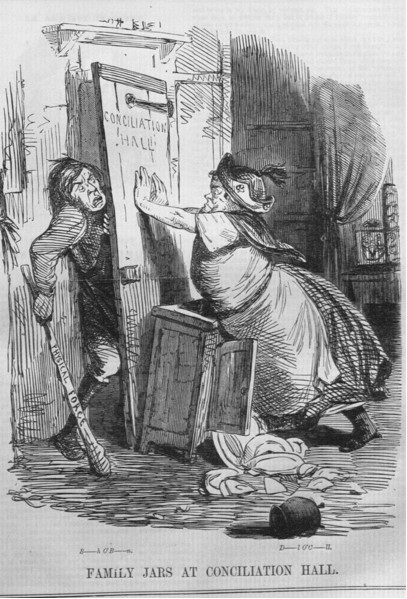
<10>John Leech’s “Rebecca and her Daughters” (5.5) depicts more clearly how feminized violence averts concern about protest within England (Figure 3). Leech parallels O’Connell’s political fight against England with the popular Welsh rioters known as Rebecca and her daughters. The Poor Law and new Tithe Law enraged these protestors from South Wales; they attacked tollgates and their keepers as a form of social protest. Described as “the strangest series of riots that has occurred in our time,” the riots began in the summer of 1839, ceased suddenly, and broke out again in the winter of 1842 (Williams 4). This group of marauders used their interpretation of Genesis 24:60 as a reason for their actions: “And they blessed Rebekah, and said unto her, Thou art our sister, be thou the mother of thousands of millions, and let thy seed possess the gate of those which hate them” (qtd in Altick 204-05). In Leech’s picture, Robert Peel is the tolltaker, O’Connell is Rebecca, and Rebecca’s Daughters are members of the Repeal Association. Once again attired in women’s clothes, O’Connell hews down the symbolic tollgate of Church Rates, Union, Tithes, and Poor Law. One of his followers, wearing a bonnet and a dress, saws the “Union” in half. Numerous masquerading “women” wildly wave torches, saws, and axes in the air. The differences between England’s typical explanation of the causes for unrest in South Wales and Punch’s use of imagery from the actual riots to criticize the political fight between Peel and O’Connell reveal the importance of gender and location: feminized violence occurring in places other than England transfers social anxiety about Chartist riots onto a controllable threat, in this case, the Irish.
<11>The Rebecca Riots captured England’s attention, especially when the group turned their focus temporarily away from tollgates in 1843 in order to destroy the Carmarthen workhouse. This particular act drew attention, not only because the attendance was the highest—the crowd was estimated at between 10,000 and 12,000—but also because of the target (Thomis and Grimmett 142). Although some cited the Poor Laws as one of the catalysts of the riots, Edwin Chadwick warned the Poor Law Commissioners that the Rebecca Riots were not a reaction to the Poor Law. Interestingly, English newspapers, particularly The Times, identified the cause as social distress due to high rents—not political disaffection or opposition to government—thus purposely distinguishing the Rebecca Riots from Chartism. Even the Chartist leaders disassociated from these riots, pointing out that “the Rebecca Riots were a revolt of the farmers and not of the workers, for artisans and farm labourers paid no turnpike tolls” (Williams 150). This distinction between agrarian farmers and artisans is significant. While many of the working-class protests in England were driven by the changes stemming from industrialism and machinery, South Wales was far behind England in this area; in fact, farmers still used antiquated implements. As David Williams states, “in upper parts of Wales, even by 1844 farmers still scarcely used wagons (instead they used sledges). Threshing was still done by the flail on barn planks, which practically means that machinery breaking so prevalent in England did not occur much in Wales because there wasn’t much machinery” (74). Once again, Punch could depict the violent imagery of the Rebecca Riots as humorous because these riots did not occur within the borders of England and because the attributed contributing factors of unrest were not explicitly related to Chartist complaints and concerns.
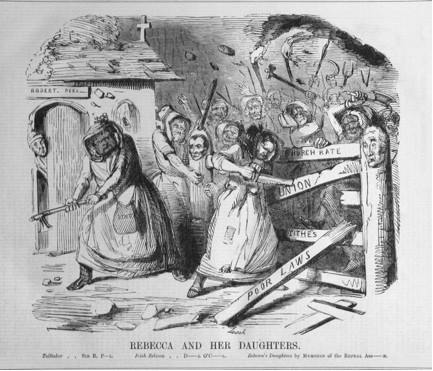
<12>Portraying this type of violence as feminine is as important as placing it outside England’s geographic boundaries. Interestingly, the Rebecca Riots were not the only working-class protests that used women as symbols of protest. As Malcom Thomis and Jennifer Grimmett point out, “men dressed themselves in female attire, and quasi-women appeared in Luddism, the Swing riots, Scotch Cattle, the Rebecca riots and the Scottish Clearance riots” (138). Kevin Binfield examines the oddity and complexity of cross-dressing, arguing that the Luddite riots are markers of “’homindustrial’ desire and of changes in working-class gender thinking, especially concepts of masculinity and masculine heroism” (29). Binfield argues that the Luddite riots, including the acts of cross-dressing, demonstrate the “vigorous promotion of each other’s interests” as more important than masculinity and artisan skill since wearing feminine clothing created anonymity and de-emphasized a specific person as leader of the protests (38). When using this image, then, Punch’s artists expropriate the image of working-class men dressing as women in order to remove the threatening purpose behind the actual riots: working-class communalism.
<13>In part, the image of men dressed as women subverted from working-class purposes because these representations connote lack of manly character; instead of anonymity to protect and promote a cause, these “women” are irrational and thus violent. Therefore, these images can be comedic because they lack masculine rationality, undermining the authority of the working class movement. Whether protecting Ireland from attacks within the country or assailing England’s politics, O’Connell’s feminized depiction symbolically controls his political threat. Because O’Connell is frequently attired in feminine clothing and he is constantly aggressive, Punch’s illustrations contrast with their illustrations images of the working-class movements within England. In the illustrations discussed so far, the artists are able to expropriate the images of cross-dressers, in part, because the images are set in places outside of England. When the artists portray British laborers within England they cannot use the same images of comedic, feminized violence.
Charity Begins at Home
<14>When addressing the poor conditions of Britain’s working class, many middle-class writers and authors endorsed charity and other seemingly philanthropic efforts as a solution to poverty and its accompanying unrest. Punch mirrors these middle-class texts in its portrayal of the suffering working classes in England. In comparison to their depictions of the violent Irish, snobs, and key Parliamentary figures, Punch’s artists typically portray the working classes as oppressed victims, a concept illustrated frequently in visual pairings of the upper and lower classes. As a result, pictures of the suffering male laborer are predictably “tragic,” especially during the 1840s, as is evident in Henry Silver’s account of one of Punch’s many weekly meetings. On March 2, 1859, Horace Mayhew, F.M. Evans, and Leech argued about how to illustrate Parliamentary debates on the Reform Bill that had been introduced by Disraeli earlier in the week:
Leech wants to know if Ponny (Mayhew) would not prefer a good old-fashioned tragic cartoon of the virtuous and starving British Workman, with ragged wife and children, and Death a ghastly apparition in the background. This leads to a little spar between Ponny and ‘Pater’ Evans…Pater calmly answers that times are altered…Strong words have done their work, and there’s no longer need of them. Nobody now talks about the trampled working man, nor goes trumpeting abroad the dignity of labour. (qtd. in Spielmann 71)
This dispute between Leech and Mayhew in 1859 affirms the purpose in portraying the British laborer as tragic in the 40s: these images acted as “strong words” that compelled leaders—not the working classes—to enact change. These visual depictions rely upon the tension from pairing the “trampled working man” with idealistic notions of the “dignity of labour.” In other words, the compelling political force of the pictures is the atrocity of the laborer’s inability to work, of his inability to gain dignity through his labor, an atrocity that is inherently based on emasculation.
<15>Perhaps the best example of this type of emasculation is in Friedrich Engels’s The Condition of the Working Class in England (1844). Engels relates a story of a Lancaster man who was forced to stay home while his wife worked. He describes the man’s emasculating tears while he mends his wife’s stockings by the fire, summarizing the atrocity in this way:
Can anyone imagine a more insane state of things than that described in this letter? And yet his condition, which unsexes the man and takes from the woman all womanliness without being able to bestow upon the man true womanliness or the woman true manliness—this condition which degrades, in the most shameful way, both sexes…is the last result of our much-praised civilization. (155)
According to Engels, the degradation of industrialized society stems from unsexing the man, disallowing him to provide a living for his family through masculine work. Not only does Engels’s assessment demonstrate the Evangelical sense of moral manly character through work, it also points to the man’s loss of authority. As Tosh states, the “home-loving man was losing out on all-male conviviality” because “the man who spent too much time in the company of wife and daughters might become effeminized, at the expense of both his manly vigour and his familial authority” (70).
<16>This image of the emasculated victimized male laborer contrasts starkly with images discussed previously, even though both are associated with feminine traits. Unlike the portrayal of O’Connell as a powerful and violent cross-dresser, the artists do not endow British male laborers with any violent propensities or agency. Instead, the conditions the laborer faces weakens him. Punch’s illustrations feminize O’Connell by attiring him in women’s clothing, but he is still seen as actively resisting, if not attacking those who come cross him. In contrast, British laborers neither defend themselves against upper class adversaries nor protest the same kinds of unjust laws as illustrated in “Rebecca and her Daughters.” The British laborers do not wear femininity; instead they are unsexed, emasculated, first by removing the most obvious signs of manliness—their ability to labor—and then by confining them within the domestic space or by domestic duties.(4) In other words, while O’Connell’s activities may be feminized, the British laborers are emasculated. The difference is based on two aspects of sexual character. In O’Connell’s depiction, dressing him as a woman allows Punch to criticize his irrational, emotional actions. In the images of British laborers, emasculating the laborer takes away his all-male associations and household authority.
<17>Almost a perfect match to the “tragic cartoon of the virtuous and starving British Workman,” Leech’s “The Home of the Rick-Burner” (7.17) depicts a distraught working-class father near the bed of his dead wife, surrounded by his four small children (Figure 4). Instead of Death, however, Satan, barely visible because of shading and outlining, hovers above the man’s head offering him a lighted torch. While not advocating rick burning—the tempter to rick-burning is, after all, Satan—the illustration sympathizes with the laborer’s desperation, thus acting as a means of criticizing the negative effects of the Poor Law. In fact, The Times stated that admirers of the Poor Law should be given a copy of Leech’s drawing because of its ability to portray this tragic image (Altick 205). As Gertrude Himmelfarb argues, the social debate regarding the Poor Laws led to distinctions between the able-bodied pauper who could work, but chose not to, and the poor laborer who desired to work, but could not (161-88). In short, the value of work is the underlying message of both the social debates on the New Poor Laws and Leech’s illustration; emasculating the male worker emphasizes the tragedy of unsexing a dignified, noble laborer who wants to work, but cannot.
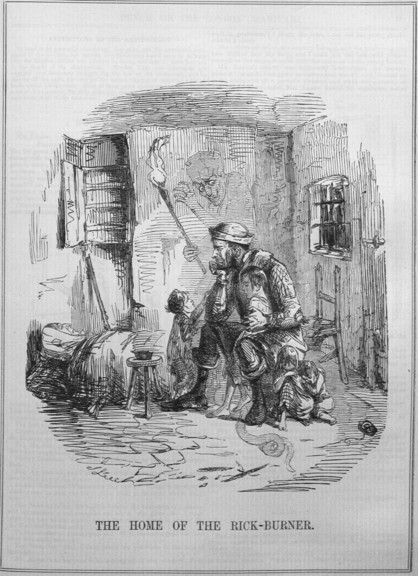
<18>Because Leech’s illustration also emphasizes the domestic space, maternal duties, and the lack of tools, however, it does more than simply “unsex” the laborer; he becomes a non-threatening figure because of his loss of manly authority. He does not rule over the house but is instead confined by it. From the bars on the small window on the left to the claustrophobic presence of the ceiling, the laborer is completely imprisoned. While Satan might tempt him to burn as a desperate act, he cannot actually do so while he is trapped in the domestic space. Unlike the idealized and glorified images of the male laboring body with sleeves rolled up and veins protruding from muscular arms, such as the navvies in Ford Madox Brown’s Work, this worker is weak and emaciated, and he holds children, not tools. These are all signs that he has been robbed of his masculinity. As such, he is an object of weakness, a victim who elicits charity and pity, instead of a protestor who is a threat. One might argue that the title implies this distraught father, the “Rick-Burner,” will indeed fall prey to Satan’s temptations and commit future acts of violence. However, Leech does not portray this man torching property or rioting as in “Rebecca and Her Daughters,” a significant omission that is evident in other illustrations as well. As long as he remains emasculated in his home, his depiction does not emphasize his agency to violently protest.
<19>Leech depicts another desperate, emasculated male laborer in “The Agricultural Question Settled” (8.39), which more clearly demonstrates the connection between the emasculated working-class male and upper-class charity and solutions (Figure 5). In this illustration Peel responds to an approaching farm laborer and his family saying, “I’m very sorry, my good man, but I can do nothing for you,” a phrase that Altick recognizes as the same Peel gave in 1846 to a delegation of starving factory workers (205). By drawing church towers in the background, Leech also implicitly criticizes the social debate over the Poor Laws and the parish’s role in providing relief. In this case, the government, the church, and the landowners refuse social responsibility. The message is, once again, to encourage those with power to act properly, not to give this laborer power and agency. Despite his angry glare, a stance that seems to indicate the beginning of a physical confrontation, this laborer is not threatening. His hands, though seemingly balled into threatening fists, are instead balled for the purpose of holding his children’s hands. Encircled by his family, he does not resort to violence because he cannot. With his wife and children behind him, and two more children holding each of his hands, his seemingly intimidating fists and stance are rendered powerless, a melodramatic state that is accentuated by the lack of any tools or torches. Perhaps his daughter’s direct gaze at the reader most clearly states who holds the power to fix this situation; she appears to appeal to the Punch readers for help. The pictures of the British working-class male may be addressing the same laws that drove the cross-dressing Irish to attack Peel’s metaphorical tollgate, but this Englishman does not hold any tools. Any action besides caring for his family is removed from the scene of this desperate male laborer.
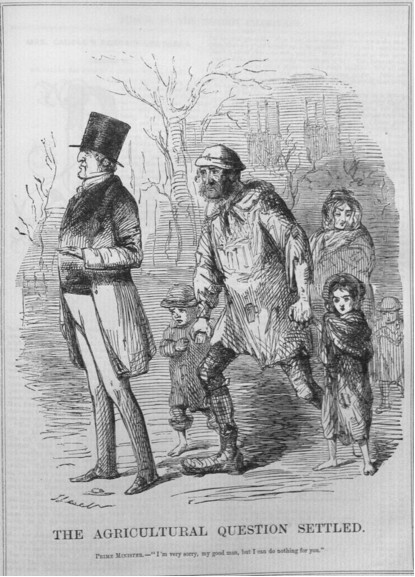
<20>Punch illustrations of the victimized male laborer compel the upper classes to find solutions. However, the illustrations change when addressing the working classes’ attempts to find solutions, specifically through the social movement and unions. The laborer is still emasculated, but instead of removing his authority by confining him to home and children, his emasculation in these illustrations points to his lack of manly sexual character, to his moral degradation because he chooses notto work. Working-class movements continued to grow throughout the mid-1800s, mostly through trade unions, despite the failure of Chartism. In the first half of 1861, Punch published a series of three pictures tracing the detrimental effects of strikes. Like the visual narrative sequences of predecessors like William Hogarth and George Cruikshank, in which a series of pictures visually mark the progressive deterioration of a member of the working class, these three illustrationschart the same laborer’s path toward pauperism and poverty. In the first illustration, “‘Strike, But Hear Me.’ – Don’t Quarrel with Bread and Butter” (40.141), Punch lectures a laborer who is considering striking (Figure 6). Although he is in a workshop surrounded by the tools of his trade, this laborer is not working. Arms crossed as he leans against a pole, he receives a lecture from Punch for refusing to work, the source of his downfall in the final picture. The second picture, “The British Slave” (40.163), plays not only with the rhetorical use of the word “slave” in industrial criticism, but also with the laborer’s next step toward poverty (Figure 7). A fat man with a stubby red nose, the “Disinterested Delegate” looks angrily at the melancholy laborer who has clearly stated his desire to return to work. On the floor, a sheet of paper announces reasonable pay and half-day holiday on Saturday, indicating there is good-paying work available. The delegate says, “Want to Go to Work Do Yer? Goin’ to Give in, Are Yer? Not if I Know It,” revealing why the title classifies this man as a slave although he is just unemployed: the laborer’s involvement in the union does not allow him to choose to work, even if he wants to. Unmoved by the man’s wife and children huddled together and crying, the delegate refuses to allow him to work. The laborer’s clothes and facial expression mark his descent from his dignified status as laborer. He now has patches over both knees on his pants and looks sympathetically at his family with his hands in his pocket, a passive and defeated state when compared to the first picture.
<21>In the final picture, “The Strike. – Hitting Him Hard” (40.263), the laborer stands dejectedly outside the Union Workhouse door (Figure 8). His clothes are tattered and torn, and his unkempt appearance demonstrates the effects of striking. However, the presence of a peer emphasizes his degraded, emasculated state. An acquaintance—a “Non-Unionist”—in clean, well-kept clothes and with a tool in his left hand, gives him money. The presence of the tool is important; the tool implies that the Non-Unionist works, thus making him dignified and masculine in contrast to his double, the union worker who cannot work. The message is clear: work empowers a man, but refusing to work leads to poverty and emasculation. Unlike the pictures of the victimized laborers, however, this man’s emasculation is due to his lack of morals. This illustration implies that those in the union are not powerful or masculine; in fact, they are the opposite: poor emasculated paupers reliant upon the charity of their peers who choose to work.
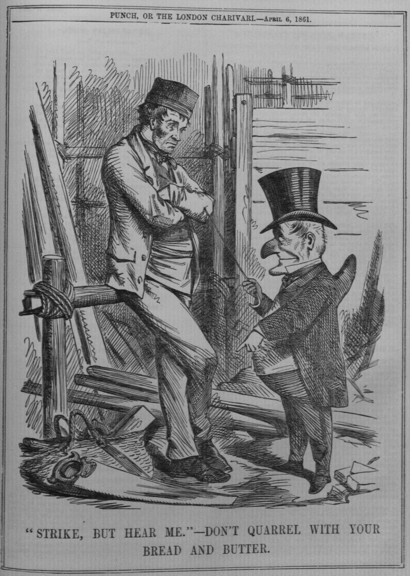

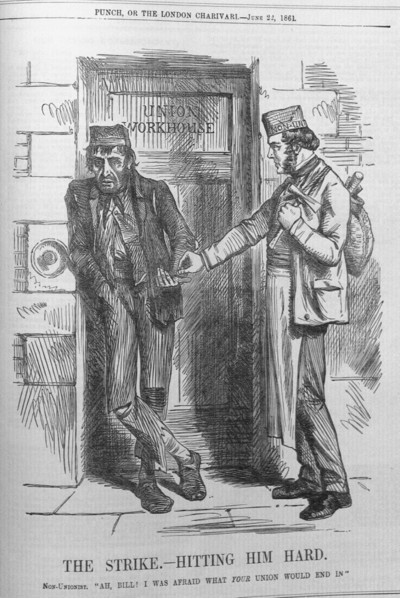
<22>Amid the many questions that these illustrations raise, perhaps the most important is this: why is this didacticism about the woes of working-class participation in trade unions and strikes in a magazine designed for the middle class? Cheap periodicals geared toward teaching morals to the working classes used illustrated series to trace the moral degradation of working-class members.(5) Punch uses this series differently. Addressed to the middle class, this series of illustrations is not really a moral lesson for union workers, but a form of alleviation for those in the middle class. Instead of addressing the legitimate concerns and threats leading to working-class strikes, these illustrations shift attention to the negative effects on the laborer’s manliness. The shift is most apparent in the first illustration; the illustration seems to address working-class concerns by at least hinting that in some instances it is okay to strike—as long as the laborer does not mess with his “bread and butter.” But this is the contradiction inherent to striking: how can a man strike and not work without being emasculated? Any apparent agency that might accrue to the laborer from striking is reimagined as lack of manly character. The absence of tools that correlates with his progressive decline reifies the laboring male’s passive, emasculated state. While this set of pictures does not confine the union man within the domestic space or give him domestic duties as in the pictures of agricultural laborers, he is emasculated through his exclusion from his work space and his refusal to pick up the tools that provide him with dignity, strength, and masculine-affirming companionship.
<23>Despite the underlying value of work in all of these illustrations of British laborers, whether positive or negative, the artists do not typically draw laboring bodies working with their masculine-making tools, even the “Non-Unionist.” The only instance in which British working-class men are actively equipped with their tools in their work environment is in “Willing Hands for India” (33.88-89). In this double-page layout, the left side depicts a line of agrarian workers, pitchforks and scythes in hand, leaving the harvesting field to join the army of laborers on the right side armed with the same tools (Figure 9). These soldiers contrast starkly with the emasculated rick burners and union workers, particularly in the case of one figure whose rolled-up sleeves reveal muscular arms. The implied meaning is that this masculine worker is heroic. Even though he is equipped with weapons similar to “Rebecca and Her Daughters,” he is not uncontrolled and chaotic like the cross-dressing Irishmen because his purpose is to defend England against mutinous acts overseas. Accordingly, these heroic soldiers, armed with pre-industrial agrarian tools, do not threaten England’s political stability; they protect it. Of course, the choice of tools is also significant. These pre-industrial tools are antiquated in comparison with the agricultural machinery typically used during the ’50s and ’60s. In equipping the laborers with these archaic tools, the artists conjoin the masculine laboring body with nostalgia for pre-industrial times, including the perception of the working classes as more content with their positions in society.(6)
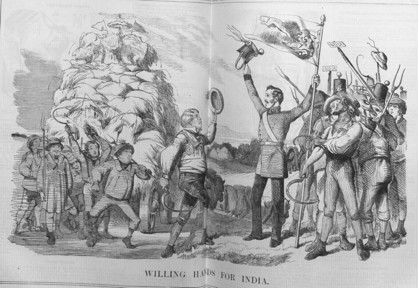
<24>Many critics have examined important aspects of labor, representations of masculinity, and the social climate, including working-class movements and consciousness during the mid-1800s.(7) In all of the illustrations, gendered representations function as the invisible baseline for constructing the national identity as stable. As Tosh states, “Masculinity, like femininity, is historically expressed in complex and confusing variety… [and] “carries public meanings of great political moment” (61). In the illustrations in Punch, men are feminized or emasculated when their acts could potentially become violent: the absence of tools and the confinement to domestic space emasculate the British male laborer, but in the hands of violent “women,” tools and weapons reaffirm the unnatural act of revolution and social protest. This paper has examined a very small portion of the multiplicity of meanings attached to masculinity and the laboring body. It does not address the ways in which Victorian novels like Adam Bede, David Copperfield, Great Expectations, Hard Times, Felix Holt, Mary Barton, North and South, and Sybil use some of these same techniques of emasculating working-class male characters with the potential to protest working and living conditions in England. It also does not address the ways in which Punch illustrations clothe politicians in the garb and activity of the workingman to criticize their productivity in government. Analyzing middle-class representations of the laboring body in any text created for the middle-class is a nebulous activity. The laboring body and the multiple connotations attached to it are both everywhere and nowhere; the laborer is visible so he can become invisible. In George Eliot’s Middlemarch, Caleb Garth reflects on the value of “the myriad-headed, myriad-handed labour by which the social body is fed, clothed, and housed” (250). He reflects that the sights and sounds of labor, “acted on him as poetry without the aid of poets, had made a philosophy for him without the aid of philosophers, a religion without the aid of theology” (251). Perhaps there is no better assessment of the laboring body in Victorian culture: it is poetry without a poet.
